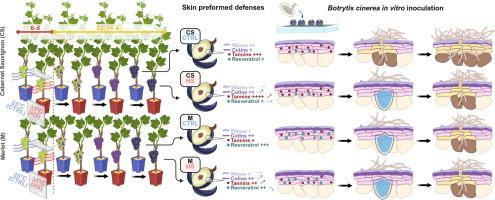Deciphering heat-enhanced resistance of grapevine berries to Botrytis cinerea highlights differential cuticular and secondary metabolite accumulations between Merlot and Cabernet Sauvignon
IF 6.8
Q1 PLANT SCIENCES
引用次数: 0
Abstract
In the context of climate change, temperature is a key abiotic driver of bunch microclimate, which, in order to reduce Botrytis cinerea development, is often managed in vineyards via practices such as leaf removal. The heat-dependent mechanisms of pathogen resistance in grapevines nevertheless remain to be fully elucidated. In this study, the effect of heat stress (HS) applied specifically to green bunches on infections caused by B. cinerea on ripe berries inoculated 23 days later was assessed for two years in a greenhouse. Bunches of the Cabernet Sauvignon (CS) and Merlot (M) cultivars were heated 6 days 8 h daily with a 10 °C increased temperature. In vitro bio tests highlighted a significant heat-enhanced resistance only in CS berries, whereas a stable constitutive resistance characterized the M berries. Bunch veraison and total sugar content were not affected by HS, rejecting its effect on maturation dynamics. Therefore, berry preformed barriers at the time of inoculation, which can hinder fungal colonization, were investigated. While HS had nearly no effect on waxes, it significantly affected the cutin content in both varieties, and more significantly its composition in CS. Similarly, the antifungal skin condensed tannins overaccumulated following HS in both cultivars, and their basal level was greater in CS than in M. Otherwise, M accumulated more stilbene and flavonoid compounds, which may have contributed to the observed varietal resistance. Finally, untargeted metabolomic data revealed a range of compounds modulated by HS in CS as potential candidates involved in resistance.

解读葡萄果实对葡萄灰霉病的热增强抗性,突出了梅洛和赤霞珠之间表皮和次生代谢物积累的差异
在气候变化的背景下,温度是葡萄束小气候的关键非生物驱动因素,为了减少葡萄灰霉病的发展,葡萄园通常通过叶片去除等措施来管理葡萄束小气候。尽管如此,葡萄藤病原菌抗性的热依赖机制仍有待充分阐明。本研究在温室中进行了为期2年的研究,研究了绿束特异性热胁迫(HS)对23天后接种的成熟浆果中灰绿杆菌侵染的影响。Cabernet Sauvignon (CS)和Merlot (M)两个品种的葡萄串在10°C的温度下加热6天,每天8小时。体外生物试验强调,只有CS浆果具有显著的热增强抗性,而M浆果具有稳定的本构抗性。HS对籽粒变性和总糖含量没有影响,排除了HS对成熟动力学的影响。因此,研究了接种时浆果预先形成的屏障,以阻止真菌定植。HS对蜡质几乎没有影响,但对两个品种的角质含量影响显著,对CS中的角质成分影响更为显著。同样,两个品种的抗真菌表皮凝聚单宁在HS后过度积累,且CS的基础水平高于M。此外,M积累了更多的苯乙烯和黄酮类化合物,这可能是观察到的品种抗性的原因。最后,非靶向代谢组学数据揭示了一系列由HS在CS中调节的化合物可能参与耐药性。
本文章由计算机程序翻译,如有差异,请以英文原文为准。
求助全文
约1分钟内获得全文
求助全文
来源期刊

Plant Stress
PLANT SCIENCES-
CiteScore
5.20
自引率
8.00%
发文量
76
审稿时长
63 days
期刊介绍:
The journal Plant Stress deals with plant (or other photoautotrophs, such as algae, cyanobacteria and lichens) responses to abiotic and biotic stress factors that can result in limited growth and productivity. Such responses can be analyzed and described at a physiological, biochemical and molecular level. Experimental approaches/technologies aiming to improve growth and productivity with a potential for downstream validation under stress conditions will also be considered. Both fundamental and applied research manuscripts are welcome, provided that clear mechanistic hypotheses are made and descriptive approaches are avoided. In addition, high-quality review articles will also be considered, provided they follow a critical approach and stimulate thought for future research avenues.
Plant Stress welcomes high-quality manuscripts related (but not limited) to interactions between plants and:
Lack of water (drought) and excess (flooding),
Salinity stress,
Elevated temperature and/or low temperature (chilling and freezing),
Hypoxia and/or anoxia,
Mineral nutrient excess and/or deficiency,
Heavy metals and/or metalloids,
Plant priming (chemical, biological, physiological, nanomaterial, biostimulant) approaches for improved stress protection,
Viral, phytoplasma, bacterial and fungal plant-pathogen interactions.
The journal welcomes basic and applied research articles, as well as review articles and short communications. All submitted manuscripts will be subject to a thorough peer-reviewing process.
 求助内容:
求助内容: 应助结果提醒方式:
应助结果提醒方式:


